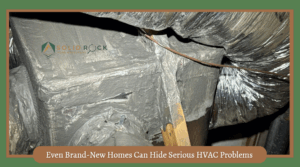It Passed a Builder Inspection… But Not Ours!
Even brand-new homes can hide dangerous HVAC defects. See what inspector Eric Rossol from Solid Rock Home Inspections discovered — and why exposed wood inside a plenum could lead to mold, structural damage, and costly repairs.
Identifying HVAC defects early can save homeowners from extensive repairs and health issues.
A Hidden Problem in a Brand-New Home
When most people walk through a newly built home, they expect perfection — everything clean, modern, and move-in ready. But even the best-looking homes can hide serious issues that aren’t visible to the average buyer or agent. During a recent new home inspection in Central Texas, our inspector noticed something unusual in the attic: a wood framing member (2×4) running directly through the HVAC plenum. At first glance, it might not seem like a big deal — but this small construction flaw can create major problems over time.
This is one of the many hidden HVAC defects that can compromise air quality and the overall integrity of the home.

Understanding Common HVAC Defects
Your HVAC system is more than just ducts and vents — it’s the lungs of your home. The plenum is the chamber that distributes conditioned air throughout the system. Inside that space, air is cool and often full of humidity or condensation — the exact environment where mold and bacteria thrive.
It’s crucial to understand that various HVAC defects may not be immediately apparent during a casual inspection.
When a piece of raw, untreated wood (like a 2×4) passes through that space, several things can happen:
- Moisture absorption: Wood can trap condensation from the air, staying damp for long periods.
- Mold and bacterial growth: The damp wood provides an ideal breeding ground for mold and microbial contamination.
- Structural damage: Over time, that moisture can cause rot, weakening the framing that supports the home.
These aren’t cosmetic problems — they’re hidden defects that can lead to expensive repairs and indoor air quality concerns.
Furthermore, addressing HVAC defects promptly can enhance the efficiency of your system and lower energy costs.
Why You Wouldn’t Notice This on a Walkthrough
This defect was completely out of sight — tucked away in the attic, surrounded by insulation and ductwork. A typical homebuyer (or even a real estate agent) wouldn’t think to look there, let alone know what to look for.
Many buyers overlook these potential HVAC defects, assuming that new homes are free from such problems.
That’s why a professional inspection is essential — even for brand-new homes that just passed builder and city inspections.
Builders often subcontract HVAC and framing work to different crews. When communication breaks down, oversights like this can easily slip through the cracks.
Failing to address these HVAC defects can lead to significant long-term issues that impact both safety and comfort.
Featured Inspector: Eric Rossol
This hidden HVAC defect was discovered by Eric Rossol, one of our highly trained inspectors at Solid Rock Home Inspections.
He is dedicated to uncovering hidden HVAC defects that could jeopardize your home’s living conditions.
Eric is both a Licensed TREC Home Inspector and a Licensed Mold Assessment Technician, giving him a unique perspective when it comes to identifying issues related to moisture, air quality, and structural health.
Credentials:
- Texas Real Estate Commission (TREC) License #23430
- Mold Assessment Technician (MAT) License #1491
- Texas Department of Agriculture (TDA) License #0829054
With Eric’s dual qualifications, he recognized immediately that this wasn’t just a construction flaw — it was a potential source of mold growth and long-term structural deterioration. His attention to detail is exactly why our clients trust Solid Rock Home Inspections to protect their investments. Eric’s expertise ensures that no HVAC defects go unnoticed, protecting your investment.
The Bigger Picture: HVAC Systems and Indoor Air Quality
HVAC systems are often overlooked when it comes to indoor health, yet they play a huge role in the air you breathe. When moisture or microbial growth occurs inside the system, it can spread spores and bacteria throughout the house every time the air runs. Homeowners must be aware of potential HVAC defects that can affect the safety of their indoor environment.
If you’ve ever noticed a musty odor when the A/C turns on, that’s often a sign of moisture issues inside the ductwork or plenum. Catching these issues early isn’t just about protecting your structure — it’s about protecting your family’s health.
What This Means for Homeowners and Agents
For homebuyers: Even if your home is brand new, get a third-party inspection before closing. A trained eye can catch things that builders and city inspectors might miss.
For real estate agents: Recommending an independent inspection shows your clients that you’re protecting their best interests — and it helps prevent costly post-closing surprises.
Solid Rock’s Perspective
This simple mistake — a 2×4 running through an HVAC plenum — might seem minor, but it could lead to serious long-term consequences: mold, rot, and even structural weakening. At Solid Rock Home Inspections, we specialize in finding the issues that others overlook — whether it’s behind walls, in attics, or beneath new construction finishes. Don’t assume “new” means “perfect.” Protect your investment with a detailed inspection before you buy.
Awareness of HVAC defects is essential to maintaining a healthy home and preventing costly repairs.
📞 Contact Solid Rock Home Inspections
Serving Central Texas — including Austin, San Antonio, and surrounding areas.
👉 solidrockhomeinspections.com
Protect your investment — schedule your inspection today with the experts in Central Texas!
